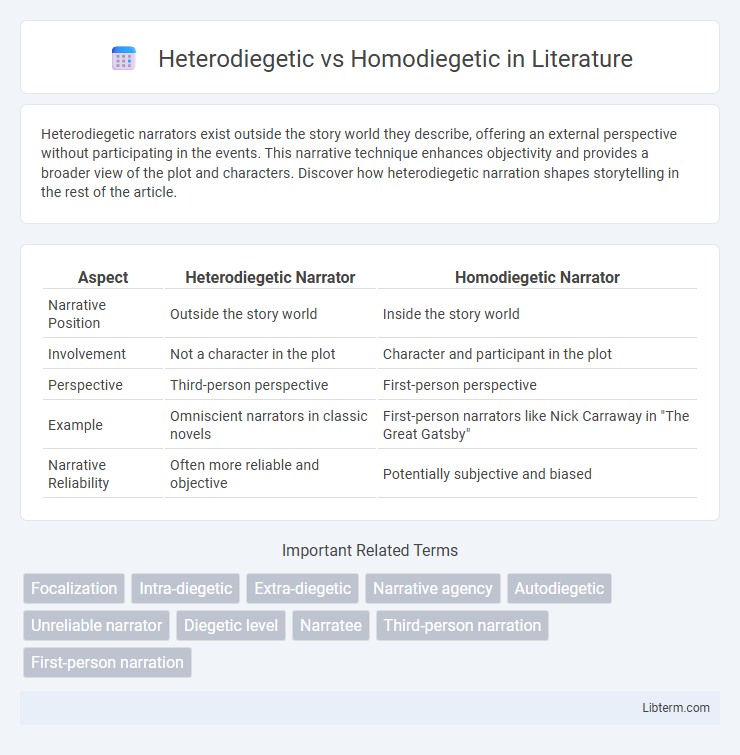Heterodiegetic narrators exist outside the story world they describe, offering an external perspective without participating in the events. This narrative technique enhances objectivity and provides a broader view of the plot and characters. Discover how heterodiegetic narration shapes storytelling in the rest of the article.
Table of Comparison
| Aspect | Heterodiegetic Narrator | Homodiegetic Narrator |
|---|---|---|
| Narrative Position | Outside the story world | Inside the story world |
| Involvement | Not a character in the plot | Character and participant in the plot |
| Perspective | Third-person perspective | First-person perspective |
| Example | Omniscient narrators in classic novels | First-person narrators like Nick Carraway in "The Great Gatsby" |
| Narrative Reliability | Often more reliable and objective | Potentially subjective and biased |
Understanding Narrative Perspectives
Heterodiegetic narrators exist outside the story world, offering an external viewpoint that often provides a more objective or omniscient perspective, while homodiegetic narrators participate within the narrative, presenting events through their personal experiences and biases. Understanding these narrative perspectives enhances the analysis of storytelling techniques, character reliability, and the depth of narrative insight. This distinction is crucial for interpreting how information is conveyed and how readers perceive the story's authenticity and emotional engagement.
Defining Heterodiegetic Narration
Heterodiegetic narration occurs when the narrator exists outside the story world and does not participate in the events, providing an external perspective on characters and actions. This type of narrator offers an omniscient or limited point of view, often revealing insights unavailable to characters within the narrative. In contrast, homodiegetic narration involves the narrator as a character within the story, actively engaging in and recounting their own experiences.
What is Homodiegetic Narration?
Homodiegetic narration occurs when the narrator is also a character within the story, providing a first-person perspective that offers intimate insights into their own experiences and thoughts. This narrative mode enhances the reader's connection to the protagonist by filtering the story through their subjective viewpoint, often leading to a deeper emotional engagement. In contrast to heterodiegetic narration, where the narrator exists outside the story world, homodiegetic narrators participate directly in the plot, shaping the narrative through their personal involvement.
Key Differences Between Heterodiegetic and Homodiegetic
Heterodiegetic narrators exist outside the story world and do not participate in the narrative events, often providing an omniscient or objective perspective, whereas homodiegetic narrators are characters within the story and recount events from their personal viewpoint. The key difference lies in narrative presence: homodiegetic narrators engage directly with the plot and other characters, while heterodiegetic narrators remain external observers. This distinction impacts narrative reliability, with homodiegetic narration typically offering subjective, potentially biased accounts, contrasted by the more detached and comprehensive insights common in heterodiegetic narration.
Narrative Distance and Reader Engagement
Heterodiegetic narrators, who exist outside the story world, create greater narrative distance by offering an external perspective that can enhance objectivity and reliability, often engaging readers through a broader, more comprehensive view. Homodiegetic narrators, as participants within the story, reduce narrative distance by delivering a subjective, intimate viewpoint that fosters deeper emotional connection and immersive reader engagement. This contrast affects how readers interpret events and characters, influencing the depth of empathy and involvement with the narrative.
Examples of Heterodiegetic Narrators in Literature
Heterodiegetic narrators appear outside the story they tell, often providing an objective and omniscient perspective, as seen in classic examples like the narrator of Jane Austen's *Pride and Prejudice* or Charles Dickens in *Great Expectations*. These narrators have knowledge beyond the characters' thoughts and experiences, offering insight into multiple storylines and characters. Their external viewpoint contrasts with homodiegetic narrators who participate in the story, making heterodiegetic narration essential for complex, multi-layered storytelling.
Illustrations of Homodiegetic Narrators
Homodiegetic narrators participate directly in the story they tell, offering a first-person perspective that enhances the emotional depth and reliability of the narrative. Classic examples include Holden Caulfield in J.D. Salinger's *The Catcher in the Rye*, whose personal insights and subjective experiences shape readers' understanding of the plot. These narrators provide intimate access to internal thoughts and motivations, creating a strong connection between the audience and the protagonist's world.
Effects on Storytelling and Plot Development
Heterodiegetic narrators, who exist outside the story world, provide a broader, often more objective perspective, allowing readers to access multiple characters' thoughts and complex plotlines, enhancing narrative depth and thematic layers. Homodiegetic narrators, participating within the story, offer subjective insights and personal biases that deepen character development and create an intimate connection with the audience, driving emotional engagement and focused plot progression. The choice between heterodiegetic and homodiegetic narration significantly influences storytelling by shaping narrative reliability, focalization, and the unfolding of events in literary works.
Choosing the Right Narrative Voice
Choosing the right narrative voice involves distinguishing between heterodiegetic and homodiegetic narrators, where a homodiegetic narrator participates in the story they tell, providing an intimate, subjective perspective. In contrast, a heterodiegetic narrator exists outside the story world, offering an omniscient or limited viewpoint without personal involvement, which enhances objectivity and broader narrative scope. Understanding these distinctions aids writers in refining narrative distance, reliability, and reader engagement to suit the story's thematic and emotional goals.
Conclusion: The Impact of Narrative Perspective
Heterodiegetic and homodiegetic narrators shape narrative perspective by determining the degree of involvement and reliability within a story. A heterodiegetic narrator, who exists outside the story world, often provides an omniscient, objective viewpoint, enhancing the reader's understanding of multiple characters and events. In contrast, a homodiegetic narrator participates in the story, offering a subjective, limited perspective that deepens emotional engagement and personal insight.
Heterodiegetic Infographic

 libterm.com
libterm.com